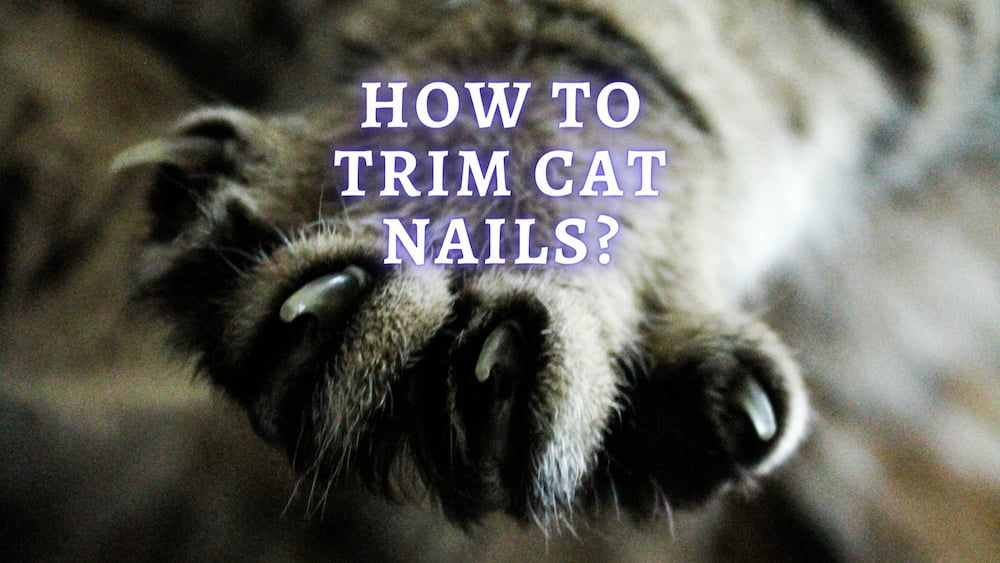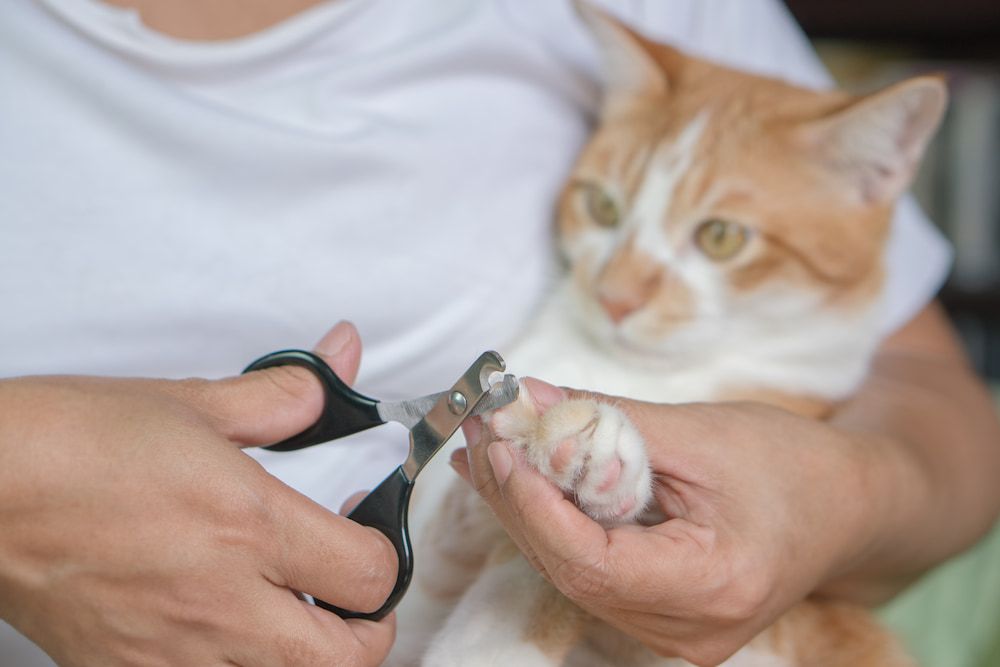How To Trim Cat Nails? Step-by-step Guide For Trimming Your Cat’s Nails
Written by:
Author: Seb Jenkins
Seb is a professional SEO writer with a degree in Journalism, he has five years of experience in writing and editing. Seb specializes in topics like dog and cat breeds, aquarium guides, and pet care. He is passionate about educating and entertaining animal owners worldwide. In his spare time, Seb enjoys writing fiction novels.
View all 83 articlesLearn about our editorial process and veterinary review board.
Reviewed by:
Veterinary review
by Dr. Linda Simon
Dr. Linda Simon is a veterinary surgeon working with seven years of experience. She is a fellow of the British Veterinary Association and specializing in animal medicine. Also, she has been the Woman magazine resident vet for the past two years and writes a regular column for them, focusing on pets and their health.
View all 30 articlesLearn about our veterinary review board
Viewed: 272
Updated on: 06/22/2023
Any long-term cat owner will know about the importance of keeping those nails nice and short for various reasons. However, acknowledging a job that needs to be done and actually carrying that job out are two very different things. When cutting nails, you need to ensure your cat is comfortable and cutting at the right point to avoid any pain. Some cats will also decide they don’t want their nails to be trimmed, which is a whole other task in itself. So, the whole nail-cutting process can be daunting, especially for new cat owners. Fortunately, we have compiled a list of top tips to get you through your nail-cutting journey as seamlessly as possible.
Do all cats need their nails trimmed?
Not all cats require regular nail trimming sessions. Outdoor cats often regulate the length of their own nails by running around and climbing all day. The more active they are, the more the world naturally grinds their nails down and prevents them from getting too long. However, indoor cats sometimes struggle with overgrown nails, as do older cats, arthritic cats, and generally less active cats. If your cat does not get as much exercise or does not have as much space to roam freely, then regular nail-cutting sessions may be required. If you are unsure about the kind of length that requires a trim, feel free to consult your vet.
What happens if you don’t trim your cat’s nails?
This is not an issue for those whose claws wear themselves down. For cats whose nails grow too long without intervention, it isn’t much fun for anyone involved. Once a cat’s nails get too long, they can become uncomfortable for your four-legged friend. Imagine walking around on extra-long nails all day long! If an overgrown nail becomes a very overgrown nail, it can even cause injury to your cat. Once they curl over, they can become ingrown and dig into the pad of the paw, which can result in infection. On the human side of things, longer cat nails can get caught on your clothing and furniture and even cause injury to your skin when you’re just trying to enjoy some snuggles.
Step-by-step guide for trimming your cat’s nails
Let’s take you through the process step by step…
- Invest in the right tools – Purchase a good quality pair of cat nail clippers, which can be found online or in pet shops. Having a good source of light and a container to catch the clippings in is also a good idea.
- Take it slow – You can’t just scoop up your kitty and get to cutting when they’ve not had their claws trimmed before. You have to introduce them to the clippers and the process slowly to make it a comfortable experience for all involved. Hold them in your lap in the position you would need to cut their nails to get them used to it. Then start touching their paws. Then let them see and smell the clippers. Clip some spaghetti to get them used to the noise. Offer positive reinforcement at every step. This should be done over a period of weeks.
- Practice makes perfect – Practice using the clippers on some spaghetti in the same position you plan on using for your cat. You can always look at online video tutorials to assist you too.
- Set up a space – Pick your place ahead of time. You need somewhere comfortable to sit for both human and cat, with good enough lighting to see what you are doing.
- Relaxed kitty – Choose a time when your cat already seems relaxed, rather than interrupting their high-energy playtime. Right after dinner time or when they seem sleepy is a great time. Just treat it like any other cuddle session.
- Locate the quick – Massage the paw pads, starting with the front paws, and press gently until you see the claws become exposed. You should then be able to extend the nails to get them into a prime cutting position. Do not press too hard or try to force anything. Be gentle and kind. The clear part of the claw is the cuttable section, while the pink section is called a quick and should be avoided.
- Time to trim – Trim the clear part of the nail, avoid the quick, and repeat for every nail. Remember to also cut the dewclaw on each of the front legs. Have some styptic powder nearby in case you accidentally hit a quick.
- Positive reinforcement – Give your pet a lot of praise, pets, and a treat at the end of a clipping session. The more positive you make the experience for them, the easier future trims will be.
- Be patient – The trimming process may not go smoothly every time. Just stay patient and never get angry at your cat. You can wrap them in a towel to keep them still or simply come back later if they do not seem up for it.
READ MORE: How to Restrain a Cat to Clip Nails?
How often should you trim a cat’s nails?
The best way to maintain your nail trimming schedule is to judge by eye. You will start to learn when your cat’s nails are getting too long just by the look of them, not to mention the clicking sound when they walk around on hard floors. Generally speaking, we recommend trimming your cat’s nails once every few weeks. If they still seem pretty short, you can leave it longer. If they seem long then feel free to cut them early.
Will claw trimming prevent scratching?
Cats with longer nails can tend to scratch up your furniture or even your own limbs. Not only can this cause damage to property around the home, but it can also result in infection if your cat’s nails are carrying bacteria when they scratch you. However, scratching is a very natural behavior for many cats. While some do it to keep their own nails at the perfect length, it is also not an urge that will vanish once their nails have been trimmed. The best thing you can do is let your cat be themselves but give them a safe space to do that. Invest in some scratching posts and mats and replace them once they get worn down. Having a scratching post or cat trees with different surfaces also gives some nice variation for your kitty. Not only will this give your kitty a safe place to scratch, but it will also help to regulate their nail length.
What should I do if I accidentally hit the quick and my cat’s nail bleeds?
If you cut your cat’s nails for long enough, the chances are it might go wrong once or twice. While you should always avoid hitting the quick and causing pain to your little bundle of joy, it is also important to know what to do if that does ever happen. When trimming your cat’s nails, you should only ever make small cuts at a time. That way, if you ever do hit the quick, you will only just graze it. This will cause a little bit of discomfort to your cat and maybe a bit of blood – not too dissimilar from when a human cuts their nails a little too short. We recommend getting some styptic powder and applying a small amount to the top of the bleeding nail (cornstarch or flour are decent home remedy alternatives).
When to take your cat to a veterinarian?
Some cats just do not like having their nails trimmed and will outright refuse to let you do it. When a cat wants to struggle and run away, they are up there with the most talented creatures in the animal kingdom. Unfortunately, there is very little you can do in this situation, but the trimming job still needs to be done. It’s time to call in a professional.
You can hire the help of a professional groomer, but asking a vet for assistance is the safest option. The vast majority of vet clinics provide cat nail trimming services and are far more experienced in the process, and have the equipment to make it a lot easier. They may even give your cat a sedative to calm them down while they cut their nails. This would be uncommon.
You should also bring your cat to the vet if you notice any nail-related problems. For instance, if your cat’s nails are getting too long and starting to curl back into the paw pad, then your vet should be consulted. The last thing you want is an infection. You should also keep an eye out for any bleeding or swelling around the nails/paws. Your cat may limp and lick their paws to indicate something is wrong.
There is a chance that your vet may even advise you against trimming your cat’s nails because they are already at a healthy length. Over-trimming and hitting the quick can cause a lot more harm than good.
People also ask
Is it necessary to trim a cat’s claws?
It varies from cat to cat. Outdoor and active kitties often keep their own nails trimmed from natural wear. Indoor, older felines or cats with arthritic often need help with nail trimming.
How do you trim a cat’s nails when they don’t like it?
Be patient. Use positive reinforcement. Wrap them in a towel to keep them still. Get them used to the position and equipment. If they still don’t let you trim their nails, you may have to take them to the vet.
Where is the quick on a cat’s nail?
The quick is the pink section of the nail and should be avoided when trimming. It contains the blood vessels and nerves.
When should I not cut a cat’s nails?
You should not cut your cat’s nails if they are already at a good length. Cut them too short, and you may cause pain/injury. Ask your vet if you are unsure.
 Cat Veterinary Tips Cat Chewing Cardboard: Why Does My Cat Chew On Cardboard? Vet Advice
Cat Veterinary Tips Cat Chewing Cardboard: Why Does My Cat Chew On Cardboard? Vet Advice - 3746
- 0
 Cat Care Cat Vomit Looks Like Poop: What does your cat’s vomit say about their health?
Cat Care Cat Vomit Looks Like Poop: What does your cat’s vomit say about their health? - 3427
- 0
 Cat Care Why Does My Cat Attack My Legs? 10 Reasons Why and What To Do About It (Vet-Approved Advice)
Cat Care Why Does My Cat Attack My Legs? 10 Reasons Why and What To Do About It (Vet-Approved Advice) - 45879
- 21
 Cat Veterinary Tips Cat Stomach Gurgling: Vet Advice on Why is Your Cat Stomach Gurgling?
Cat Veterinary Tips Cat Stomach Gurgling: Vet Advice on Why is Your Cat Stomach Gurgling? - 36204
- 4
 Cat Veterinary Tips My Cat Lost its Voice: Can Cats get Laryngitis? (Vet Advice)
Cat Veterinary Tips My Cat Lost its Voice: Can Cats get Laryngitis? (Vet Advice) - 23498
- 13























